5 Fast-Growing Amish Settlements
I compared statistics from the 2003 Amish Settlements Across America by David Luthy with numbers from the 2012 Raber’s Almanac to come up with a list of 5 fast-growing Amish settlements over the past decade.
Past calculations have found the Amish population to double roughly every 18-20 years; these communities would be exceeding that, some by a significant margin.
Why “fast-growing” and not “the fastest-growing”? There are 3 caveats-
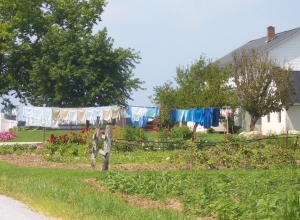
a. I only looked at settlements that were at least 4 districts in size in 2003. There may be smaller, less-established settlements that are technically experiencing a higher rate of growth.
b. Districts can vary in size. For example, for its calculations the Young Center estimates that districts in Holmes County, Ohio are 130 people in size while those in Lancaster County are significantly larger at 165 people.
c. Raber’s is not always updated so its information is not quite as reliable as other aggregate sources (ie ASAA or Young Center).
Given all that, it’s still safe to say the following 5 settlements are among the fastest-growing Amish communities over the past decade:
- Munfordville/Horse Cave, Kentucky 6 districts (2003)-13 districts (2012) The only sizeable settlement to have more than doubled over this time period. The Munfordville Amish community has seen a lot of in-migration from its parent settlement in Geauga County, Ohio.
- Kenton, Ohio 4-8 districts The Kenton Amish settlement doubled in number of church districts over the time period. Amish at Kenton (Hardin County) are noticeable by the unusual reflective tape pattern on their buggies.
- Heuvelton, New York 6-11 districts New York has seen many new Amish settlements founded in recent years. Existing settlements such as the conservative Heuvelton Amish community near the Canadian border (settled 1974) have also seen a lot of growth.
- Clark, Missouri 6-10 districts Missouri is another state with high Amish growth happening. The Clark Amish settlement in Audrain and Randolph Counties is one of the state’s 3 largest communities.
- Berne, Indiana 36-53 districts Though a few much smaller settlements may have technically added a higher % of church districts, I included the Berne Amish (Adams/Jay Counties) as the fastest-growing of large Amish settlements.
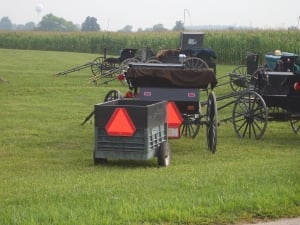
Adams County, Indiana
Why do some communities grow faster than the average?
Some are seeing a lot of people moving in from other places–for cheaper farmland, for a more traditional community, etc (see reasons Amish move).
The % of youth who join the church, and defection of baptized members also influence growth.
Finally, some are simply having family sizes larger than the 6-7 child Amish average. For instance, families in the Berne settlement average 9 children per family (see An Amish Patchwork p. 80).


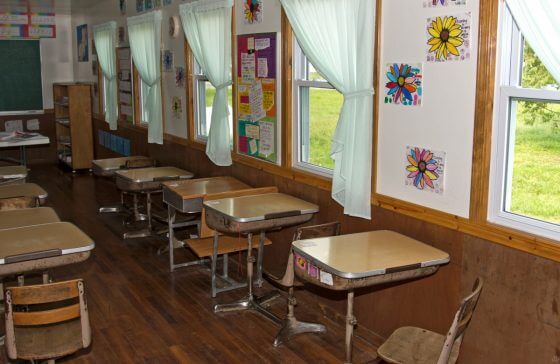
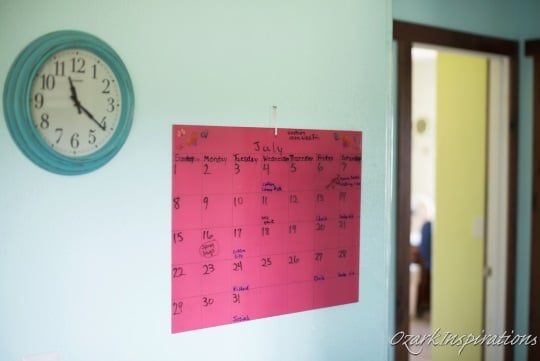

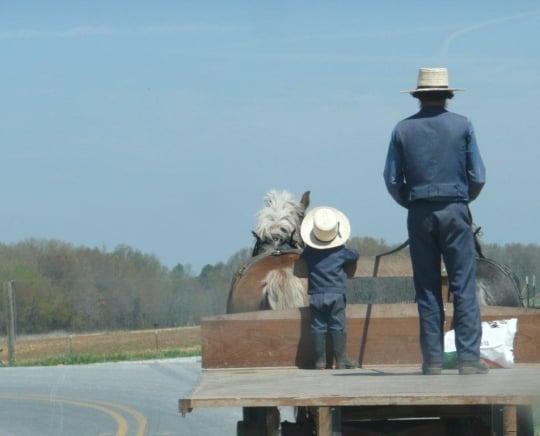
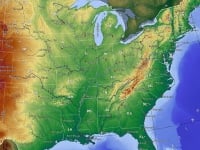
District growth
I live near the amish settlement in Buchanan County, Iowa. I really admire the way the amish live. Their way of life keeps them so connected with one another. They visit in person while we tend to visit on facebook. Here is my question regarding this post. If the average district size is 130 people for example, how large do they allow the district to get before they split it into two districts?
Iowa Amish
We’re seeing a large growth here in NE Iowa with some from the Edgewood/Clayton County community moving into Delhi (Del-High)/Delaware County.
Question for Robin Stone
Great to see the first two comments from Iowa. I would be interested in more specific directions to the Delhi area settlement, such as a main intersection. Are there many home businesses or mostly farming? Still have friends near Delhi, although now I’m closer to the Hazleton Amish in Buchanan County.
Charles it depends on the group, but 40-45 families are about the biggest the get before they’ve divided (I’m going by Holmes County here).
There are at least 1 or 2 places I know of where divisions are fewer and further between and districts get quite a bit larger, even over 50 families.
My husband and I actually stayed at an Amish House outside of Bird in Hand. Their district is quite large. They are very good people.
I actually think the Munfordville community is larger than that… we visited friends there in October, and it seems to me they said it was 8 districts.
Interesting about Berne… do you know if their growth has to do with births, or are there people moving there? If so, from where?
Thanks for filling us in…
Saloma
Saloma interesting, did you mean a number larger than 8 for Munfordville though? As for Adams Co., I’m just going to surmise that it’s mainly by the larger family size, I don’t have much info on migration in and out.
I think all of these settlements listed above have their increase due to marriage and all of these maintain most of their Amish members. Very few leave the Amish for Mennonite churches or whatever.
Labette/Neosho counties KS - swiss Amish
The folks here started moving in about the time we arrived, first ones getting here in 2006/2007 I believe. They come from Seymour MO, which came from Indiana. These are conservative Swiss Amish. Seymour has begun to get too crowded and expensive – become kind of an outlying suberb area for the Branson area.
Prices go up. Traffic grows and road safety for the buggies is an issue. Plus, just finding enough land for all the kids. They’ve grown to two districts here in SE Kansas in just these five years, and I heard talk about starting a third (at least a school). They are all one big extended family, and with the two districts the group that isn’t having church often travels to the other group. But it can get too far, especially in winter weather or such. And particularly for school, where younger families have to make two double trips a day, and families with older students capable of driving a buggie themselves nevertheless are uncomfortable having their kids go _too_ far alone. And the size of the school is an issue as well, as population is increasing so quickly. Both schools have two rooms/teachers now, and it is likely they will have another school for next fall. It is a good area for farming folk. There have been a generation of older farmers who kept holding on to their land despite inroads from the “big farm corporation” folks. Those older folks are now retiring, moving to town, or dying… and some of them selling off their land to the Amish rather than to the big farm folks they don’t much care for. So prices are, or can be, decent compared to similar land elsewhere. Whether water holds out is a concern… especially after last summer when we had so little rain during the growing months (overabundant in early spring, which flooded out a lot of things and delayed planting of others; then nothing, all summer…) Bunch of wells gave out or went down to a trickle. But so far we’re doing okay this year, and hopefully the water tables will build back up… Delightful to have this expanding Amish community here. Sara
Sara thank you for sharing this, did not know their background. There was a question on our Kansas Amish thread about an Amish store in the county:
https://amishamerica.com/kansas-amish/#comment-23228
https://amishamerica.com/kansas-amish/
reply to question from earlier blog
Earlier blog comment was:
Where, exactly is the Amish store in Labette county? Is it in Dennis? I know there are several farms in the Dennis area that are Amish owned. It was fascinating to me recently to drive through the area and notice buggy tracks and “horse apples” on certain roads. Also noticed that they have a church building. Most of the stories I have read (fiction, but well informed writing) say that most don’t meet in a common building, but rather at individual farms. I have rarely seen horse and buggy traffic in or around Parsons, but occasionally in the summer I have seen an Amish farmer selling fresh vegetables along Highway 400.
My delayed response was:
Actually, the Labette/Neosho Amish do not have a church. There is a small church near some of the original folks who settled here – which is in southern Neosho county, not Labette. But they worship in their homes, as is traditional – the church belongs to some other worship group. The store is in Neosho county – the same road as that church. It is the first e/w road in Neosho county – believe it is 20th? It is about two miles east of Gray. So you’d take Gray north (off of 400), past the bend in the road at the county line, up to the next road, turn right (east) about two miles. There is a hilled windmill out front, hard to miss. The northern labette/southern neosho Amish are a different settlement from the Chetopa Amish. The Chetopa Amish I don’t believe are Swiss, and they are stricter in some ways (according to my neighbors), but I have observed them to be far “fancier” (in dress and such) than my neighboring settlements. I believe that they also have a store – or have heard such, but don’t know where that would be located – somewhere in southern labette I would guess. Both groups grow/sell produce and also do carpentry work, both furniture and construction/building work.
As to the fellow who is/was interested in being a driver, I don’t have any contacts in the southern group. But if you write me at [email removed] I can give you some contact info for the Swiss group that are my neighbors. Sara
further comment – did a search on the Chetopa Amish, and it seems they are a “Beachy Amish” group – which explains the differing dress style they utilize. It is still very conservative, but more “styled”, with pastel colors and light hair coverings for the women.
And perhaps the person mentioning a church may have been referring to the Chetopa Amish – as apparently some Beachy Amish do utilize church buildings. I also have a question – on the earlier Kansas blog, someone mentioned a Thayer group. I know my local Swiss Amish neighbors have, in their northern district, some homesteads/farms that border almost on Thayer. Is there a separate (non-Swiss) Thayer group as well – or was the earlier discussion referring to “my” neighbors? Sara
There is a horse-and-buggy Amish group listed for Chetopa in the 2012 Raber’s guide. Beachy Amish would not use horse-drawn transport. Perhaps there are both churches represented at this location.
Well, that would explain my confusion at my neighbors calling the other Amish group “stricter” – when that doesn’t seem to make sense in relation to a Beachy group. The folks I’ve seen in town, with lighter clothing than my neighbors would wear, seem more likely to be a Beachy group. So there may be two separate settlements there. Sara
Kansas
There may be three groups. I think the Thayer, Kansas, Amish group in Neosho County comes from the Swiss Amish in Seymour, Missouri. Some of the Chetopa, Kansas, Amish group in Labette County come from Windsor, Missouri.
There is a Beachy church in Oswego, Kansas, in Labette County. The people moved in in 2003 from Hutchinson, KS, and began having services in a church house in 2006.
I was speaking of southern Labette when I said two settlements – since Erik mentioned that there is reported to be a horse and buggy settlement in Chetopa. Things are beginning to make sense now – that the Beachy folks (originally from Hutchinson KS) are in Oswego, the “stricter” Amish folks my neighbors have mentioned coming from Windsor Missouri and living in Chetopa. If the Thayer folks are Swiss Amish from Seymour, then that is actually the northern district for my neighbors – that was my guess, though Thayer is actually a bit farther north than most of their homesteads. It probably is their closest Neosho County post office though (It would be that or Galesburg).
Wow, I LIVE here, but am learning from all of you about who else lives here in my neighboring towns and counties. I guess I don’t get out much (grin). Actually, I don’t. I get to town as seldom as possible, for doctoring or once a month or so shopping. I have a special needs adult son who doesn’t handle change well, so we spend most of our time here at home – which suits me fine. The garden, the trees, the meadow, the birds, our cat – lots of good “company”. And my Amish friends are good neighbors, and we visit back and forth. Not an exciting life but a good one! Sara
Sara, the Thayer, Kansas, heading in THE BUDGET newspaper, gives a sub-title of “Parsons Community.”
Thanks Yoder – yes, that would then be the northern district of my Swiss Amish neighbors. Our post office here is Dennis, but we (I and the local Amish) go to Parsons for shopping and doctoring and such. Appreciate your clearing that up. Sara
Sara, Thanks for the Laugh
Sara Mandal-Joy, Thank you so much for the comment re: Seymour being considered sort of an outlying suburb of Branson. It brought much laughter to my day because no town in our neck of the woods (Springfield area) wants to be considered a suburb of Branson, especially with the influx of the music celebrities (mostly country). Branson which began as a good family type tourist trap is a good 60 miles from Seymour according to Google Maps. Your friends who have lived closer to that area may disagree with my opinion. God bless you and them.
Erik, thanks for the good news that the Amish population is still growing somewhere in the US.
Sure thing Carolyn, the Amish population is in fact growing in many many places–these are just some of the above average growers.
Carroll County Ohio
They are growing as well.
Good to hear
It’s good to hear the Amish are still being fruitful and multiplying. The older I get, the more I appreciate “extended family”, and the Amish have certainly provided “insurance” that they’ll be cared for in their old age. Of course, being a self-sufficient community (for the most part) makes large families a necessity. I can only hope no child gets lost in the shuffle, although I’m sure that many do (any thoughts, Saloma?).
Sara, I’m also glad to hear of Amish selling (farms) to Amish…better than developers or “factory farms” coming in. “Local” is good…for produce, jobs, families…
Alice Mary
The Swartzentruber community I’m familiar with seems to be very committed to “staying put,” as far as I can tell, but some other communities I am familiar with, especially in Tennessee and Kentucky, seem to have a lot of families go and come. I realize there are various reasons for relocation, but I’m still surprised when I meet a family that says that they’ve lived in Pennsylvania, Canada, Ohio, and Kentucky. It’s rather common, and simply astounds me. Has anybody else come across Amish “rovers”?
Just a guess, but I believe that those communities with retention and steady growth are blessed with excellent church leadership.
There’s probably a lot of truth to that Lattice.
There may be such,but I know listening to the elder folk at my neighbor’s, that their desire and intent is to be rooted in one spot… But, using drivers and buses and such, there is a -lot- of travel, and has long been. Back when polio was an issue, the Amish community had more than their fair share of cases, and were told it was because they did more “traveling” than the average folk. Its always been important to them to stay connected to relatives, and visiting/traveling was an important part of their lifestyle to accomodate that, as marriages led folks to new locations. There has been an emphasis, since understanding genetics, that meeting and marrying folks from other communities is a good thing. I know Joseph,the patriarch of the local folks, came originally from Canada, married Katy in Indiana, moved down there with her – but they then moved to Seymour to be able to have land of their own. So land constraints is another big issue for “roving” – young folks needing to move on if they want to farm, when existent farm land is already divied up or too expensive. Then Seymour became too populated and expensive, so a group moved here. But one of Joseph’s granddaughters here just married and moved to New York. So, yes, there is a lot of roving…
for visiting kinfolk, for courting and marriage, for land, and maybe some other dynamics as well. Sara
“Has anybody else come across Amish “rovers”?”
Yikes, Erik! I wish you could devise a way for respondents to make edits. Sorry about that.
Thanks for this update. I’m always interested in learning which
settlements are growing and new ones developing. I’m going to
Munfordville Sat. 4/14 to their annual spring consignment sale.
I’m going to talk with a couple of the Amish store owners I know
to see what their perspective is on the amazing growth rate of
that settlement. The Munfordville area is beautiful this
time of year and I always enjoy my visits with the Amish there.
Interesting Al, would be great to hear if you learn anything of note.
Thank you Erik, for this wonderful analysis you have done. It is very interesting to see this kind of study about the areas that attract and retain the Amish.
I think it will be fascinating to keep an eye on these five areas in the coming years. Clearly, there’s a demographic shift quietly going on, and this will bring about other changes – mostly good, one hopes, and some unexpected.
I’ve said it before – If one is looking to buy land, or for a good place to farm or start a rural business – these are 5 good places to look.
Kenton
Yay Kenton! *laughs* Nearly all my family’s from Kenton, so it’s nice to see the settlement there is doing so well. For a long time I believe it was only 2 districts. Thank you for the information!
Amish in Canada
Hi Erik,
You say on here, that the only Amish in Canada are in Ontario. That is actually not true anymore. There are now Amish living by Gladstone, Manitoba. I have a friend, who used to live by them, who told me about them, and I googled it, and it is true. There are Amish living around Gladstone, Manitoba. I hope to go there sometime in the near future. I just thought I would let you know. Maybe you will want to go there and check it out. 🙂
Destiny – Just a slight correction, but the group near Gladstone, Manitoba is an Orthodox Mennonite group–not Amish. I believe they moved there from Ontario around 2006.
A new settlement near Milaca,Minnesota. We are really excited to see and meet the Amish. Not sure how long ago the first arrived, but welcome to the area. We all enjoy the benifit Haystack Suppers.
Amish benefit Haystack supper, Milaca, Minnesota
The Milaca South Amish Community hosts a supper on the second Friday of each month from 4-7:30 p.m. at the Borgholm Township Hall located a half mile south of Bock, Minnesota, on County Road 1. A donation is requested. All proceeds help pay medical and school expenses for the local Amish community. Homemade bread, desserts and jams are also available for sale.
(Authentic Amish Haystack supper satisfies, May 2015)
http://millelacscountytimes.com/2015/05/15/authentic-amish-haystack-supper-satisfies/
“Cochran said there are two “colonies” or “populations” of Amish that have moved into Mille Lacs County and that he sees Highway 23 being the dividing line between the two groups. “However, the physical separation between the two is minimal, and without knowledge of the existence of the two colonies, most observers would come to the conclusion there is only one colony in Mille Lacs County,” Cochran’s memo to the county board stated.”
(Buggy-crossing signs rejected, Aug. 2014)
http://millelacscountytimes.com/2014/08/13/buggy-crossing-signs-rejected/
A recipe for Apple Kuchen Bars, and a photo of the Borgholm Town Hall can be seen at:
“Recipe: Apple Kuchen Bars,” Feb. 2015.
http://millelacscountytimes.com/2015/02/24/recipe-apple-kuchen-bars/
address for "the Budget newspaper" please
I would love to have information regarding a subscription to ” The Budget newspaper” Thank You Muriel
Hi Muriel, you’ll find that info at this post, it is the first publication listed: https://amishamerica.com/5-amish-publications-you-might-enjoy/
Burkes Garden, Va
In the next few years, I think the settlements in Burkes Garden, Va will make this list. Everything there is perfect for a return to the simple life. Burkes Garden will, in 10 years become a unique haven for a unity of several Amish groups to flourish. It will be interesting to see which group becomes dominate. Scholars should be ready to watch this development.
Amish settlements
How come I don’t see anything about the settlements in central N.Y.(Marathon,Summerhill,Locke,Addison,Georgetown)
This was a selection of five of the fastest growing based on a simple church district increase calculation. Sounds like the ones in you area are growing fast too? Here is our New York Amish page which might be of interest: https://amishamerica.com/new-york-amish/
5 Fast-Growing Amish Settlements
Excellent pieces. Keep wriing such kind of information on your site.
Im really impressed by it.
Hi there, Youu have done a great job. I will definitely digg it aand personally recommend to my friends.
I’m confident they will be benefited from this website.
5 Fast-Growing Amish Settlements
Awesomje issues here. I am very glad to look your post.
Thanks a lot and I am taking a look ahead too touch you.
Will you please drop me a mail?